

King David is well represented in the Index of Medieval Art database, with close to 200 subject headings covering the various scenes of his life. He is most often depicted as a richly garmented king, often with his role as the psalmist suggested by his signature harp and crown. One variant of his iconography, which I encountered while cataloguing a historiated initial from an early sixteenth-century French Psalter, presents a familiar subject in the life of David, described by the Index as David, Communicating with God (Fig. 1). However, in this example, the kneeling David adds an extra gesture to his prayer routine. Where one would expect to find reverent folded hands, David emphatically points his finger to his protruding tongue!
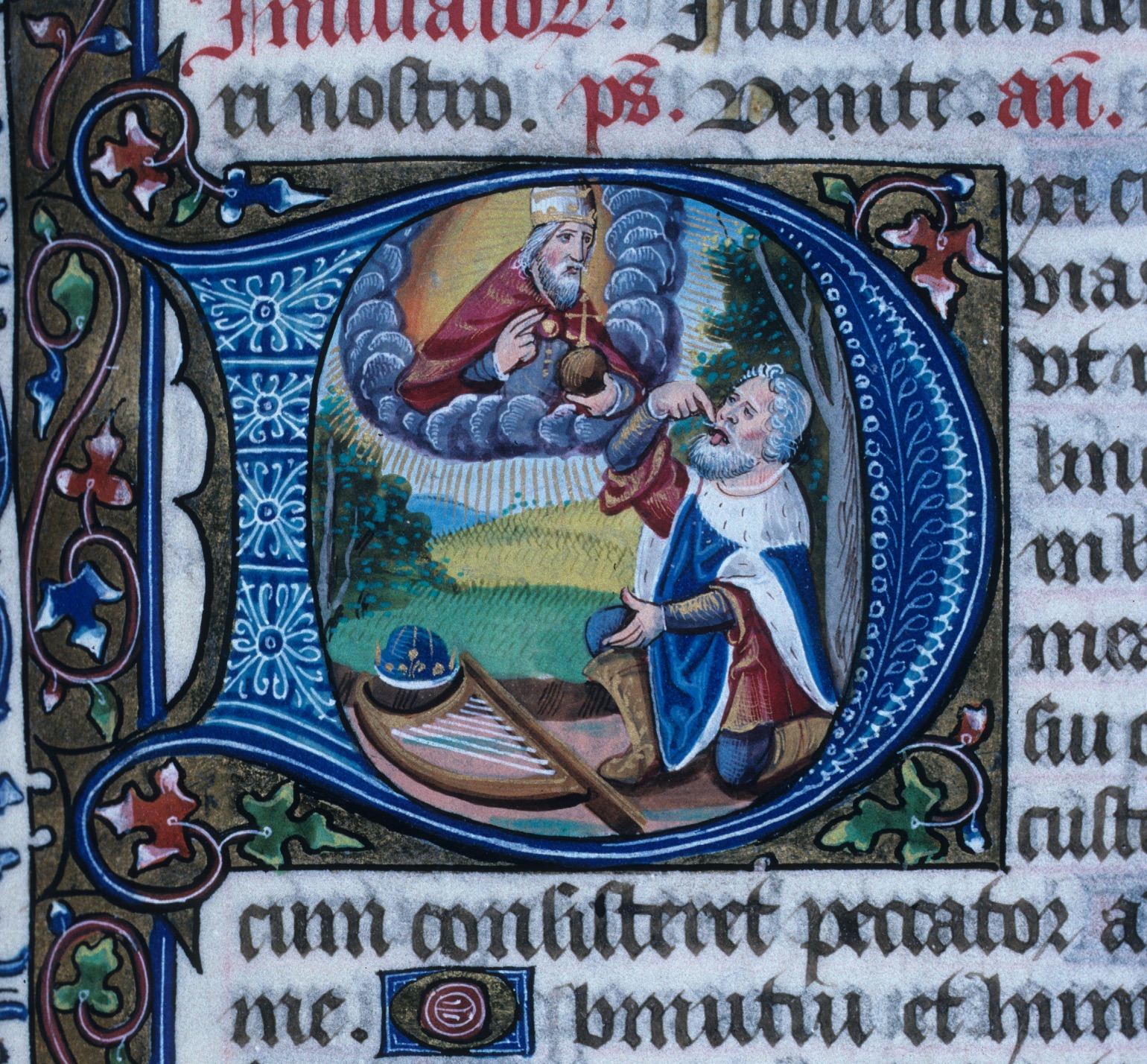
While studying this initial, I decided to use the tools in the updated Index database to explore how David’s pose and the purposeful indication of his tongue were related to the psalm verse. In this Psalter, the initial D for Dixi begins Vulgate Psalm 38, verse 2: Dixi custodiam vias meas; locutus sum in lingua mea posuri ori meo custodiam cum consisteret peccator adversum me… (Douay-Rheims Bible, accessed 22 February 2019, http://drbo.org/). Translated, this reads “I will take heed to my ways, that I sin not with my tongue. I have set guard to my mouth, when the sinner stood against me.” The tongue is mentioned one more time in this psalm at verse 5 with regard to speech, “I spoke with my tongue: O Lord, make me know my end. And what is the number of my days: that I may know what is wanting of me” (drbo.org). The image of David thus prefigures the textual passages of the psalm in that both image and text suggest the speaking and offending capabilities of the tongue. But, how often do we see David depicted with his tongue sticking out? And can we find other contexts for his expressive gesture?
I entered a simple keyword search for “tongue” in the upper right search bar on the Index database homepage and used the Subject Filter to refine my results to David, Communicating with God. Immediately, I located a much earlier scene from a Parisian Bible in the Morgan Library dated to the first quarter of the thirteenth century (Fig. 2). This initial D, also beginning Psalm 38, encloses a beardless, crowned David, looking up toward the face of God and mirroring the action of raised finger to outstretched tongue.
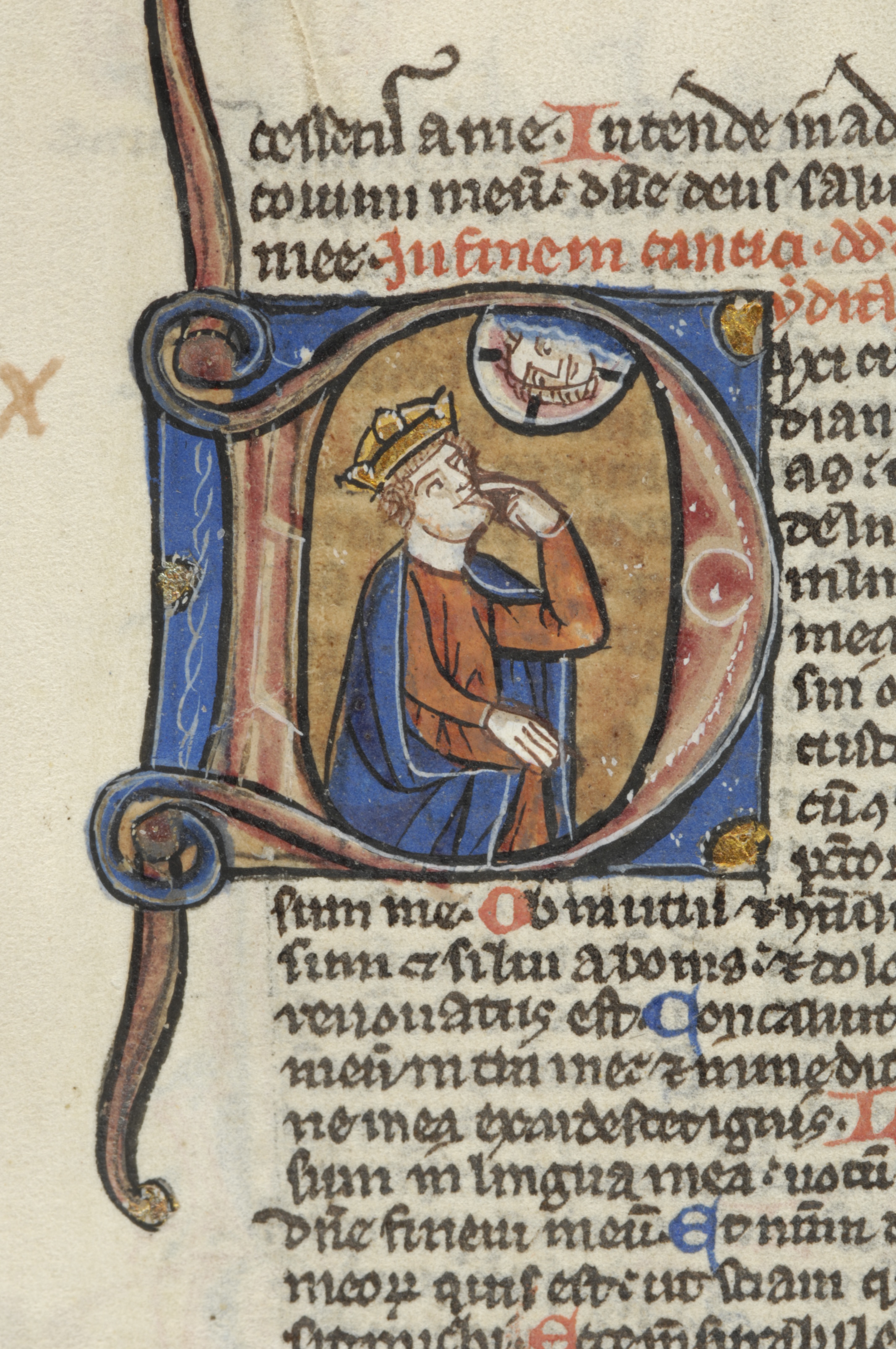
Since both of these images open Psalm 38, the presence of magnified tongues seems intended to show that significant body part that David was obliged to “sin not” with.
This connotation of the image is better understood in the context of the medieval preoccupation with the peccata linguae, or “sins of the tongue,” such as those assigned to fallen characters in the Divine Comedy and the Roman de la Rose. These transgressions of speech include flattery, duplicity, evil counsel, discord, and blasphemy. Medieval moralists also were concerned with sinful tongues: the Franciscan John of Wales (d. 1285), for example, wrote a preaching treatise called De Lingua (“The Tongue”), which outlined the proper duties of a “good” tongue as to share in ethical knowledge and to oppose its own natural “bad” inclinations.
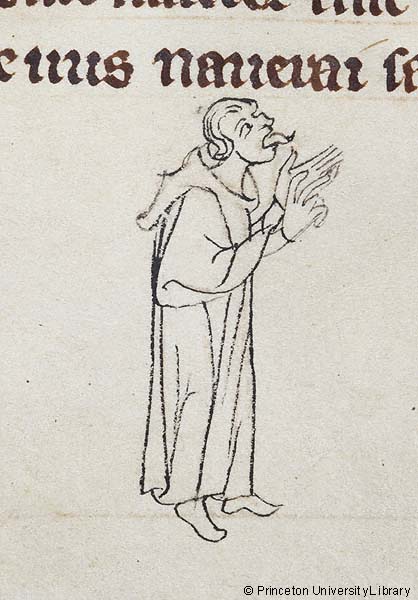
In medieval art, depictions of sinful tongues like David’s can be found in figural representations of Slander, False Seeming, and other personifications of vice. A figure identified as the Unmerciful Judge sticks out his tongue in the lower margin of a 15th century Manuel des Péchés to illustrate the Exemplum, or lesson, for the Sins of Avarice and Covetousness (Fig. 3). His long, curled tongue and raised hands suggest how insistently he imparts this lesson on the vices. However, his prominent tongue is also inherently tied to his cruel speech, offering a visual metaphor of merciless judgment.
Wishing to investigate further the iconography associated with Psalm 38, I used the Index database to browse through the numbered psalms in the Subject Browse List. Clicking the subject heading for Psalm 039 (Vulg., 038) revealed that a majority of the illustrations depict David pointing to his mouth, a common way to represent speech, but without his tongue sticking out. One such initial appears in the Noyon Psalter, attributed to the Master of the Ingeborg Psalter, in the J. Paul Getty Museum (MS. 66, fol. 41v). This suggests that the literal representations of David’s tongue were the more unusual depiction. To take this theory a step further, I repeated the keyword search for “mouth” and refined the subject to David, Communicating with God. This search yielded about 30 examples where David was indicating his closed mouth, a subject that is particularly common in manuscript initials associated with Psalm 38.
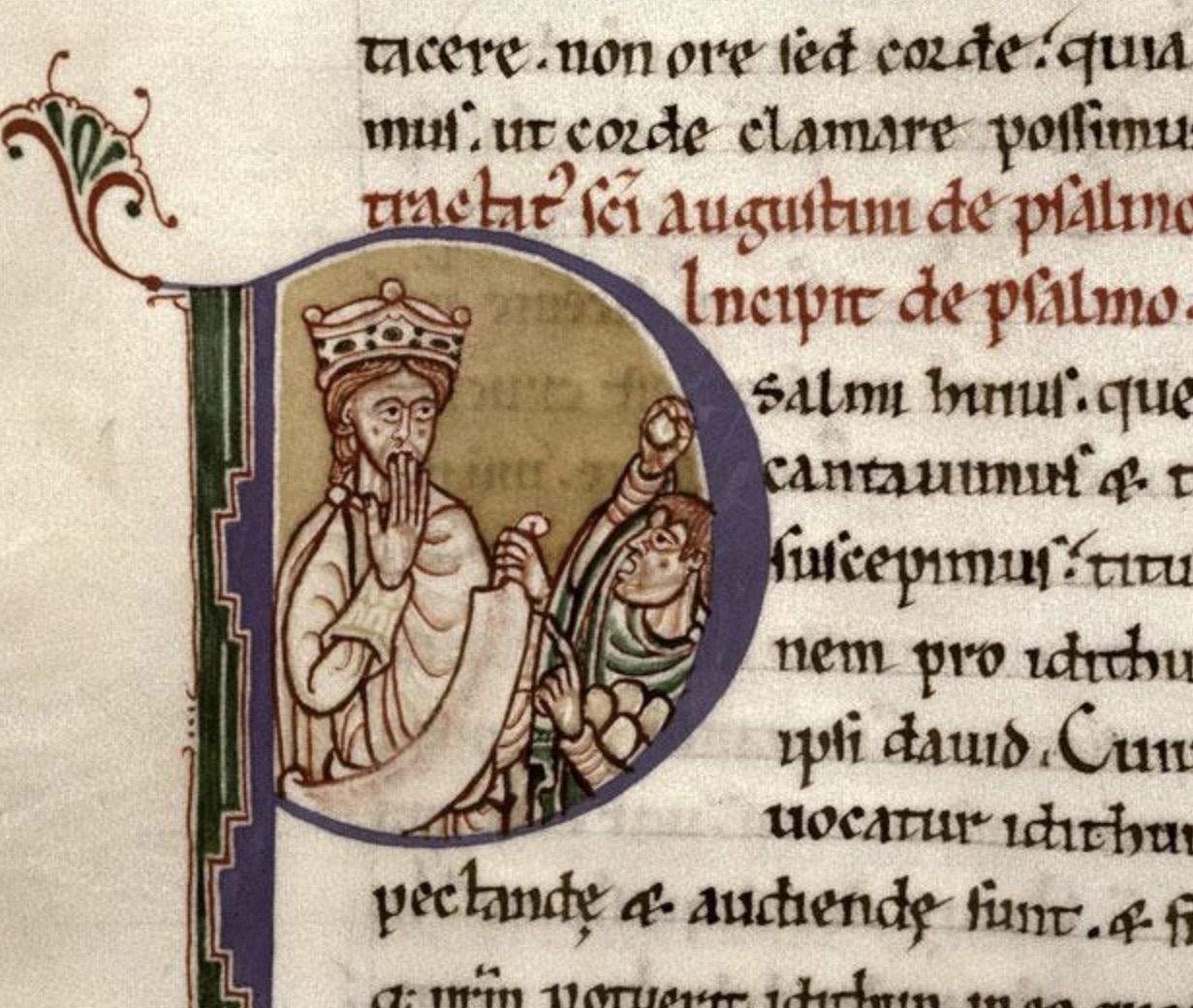
Medieval commentaries on Psalm 38 help to explain the popularity of this iconography. Theodoret’s Commentary on Psalm 38 notes the text’s emphasis on the sinfulness and “lowliness” of human nature and humanity’s need for deliverance, while Augustine wrote of the same psalm that, although the tongue was “prone to slip,” bridling it will help one stand against wicked enemies. Both commentators connected Psalm 38 to an episode in Samuel, where David was viciously pursued by Absalom and abused by Shimei, who threw sticks and stones at him while he fled from Jerusalem. That biblical narrative itself is sometimes found illustrating Psalm 38 (see the related Index subject heading David, Cursed by Shimei). In a manuscript of the Enarrationes in Psalmos, dating to the mid twelfth century, a historiated initial P encloses a crowned David covering his mouth while Shimei hurls stones at him (Fig. 4). Here, David’s cautious gesture and muted tongue show his restraint from sin, shedding light on the meaning of the gesture when it appears in the psalm initials.
Finally, I decided to broaden my search to locate all depictions of this particular body part with David. I repeated the keyword search for “tongue” and set the Subject Filter to David. This led me to a historiated initial in the twelfth century English manuscript of the Saint Albans Psalter and to another layer of iconographic context. Here, the initial E for Erucatavit, beginning Vulgate Psalm 44, encloses a seated and crowned David, who raises a pen in his right hand and with his left index finger points to his extended tongue (Fig. 5). Written in red ink above the incipit is the rubric Lingua me calamus scribae, taken from verse 2 of that Psalm, which can be translated as, “My tongue is the pen of a scrivener”(drbo.org). This verse of Psalm 44 is preceded by the mention of David’s verbum bonum, or the “good word” uttered from his heart to the king (mea regi), suggesting that goodness issues from him and through him, by way of tongue and pen.
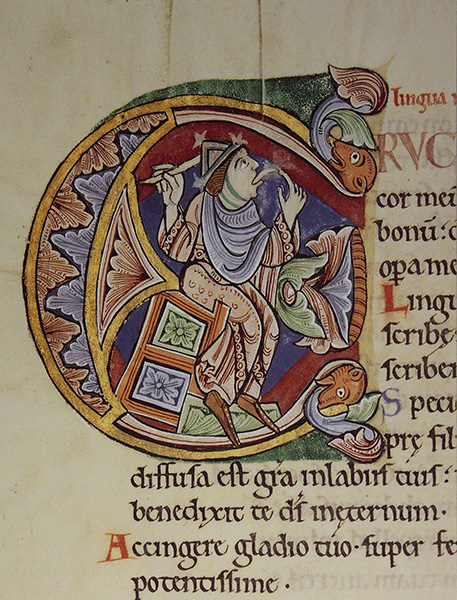
With regard to this Vulgate Psalm 44, Augustine comments,
What likeness, my brethren, what likeness, I ask, has the “tongue” of God with a transcriber’s pen? What resemblance has “the rock” to Christ? (1 Corinthians 10:4) What likeness does the “lamb” bear to our Saviour (John 1:29), or what “the lion” to the strength of the Only-Begotten? (Revelation 5:5)
(Augustine, Expositions, Digital Psalms version, p. 264)
Today, we enjoy ample use of emojis, which add expressive meaning to our messages to one another. In the Middle Ages, manuscript illuminators did not miss the opportunity to illustrate textual passages with similarly expressive visual cues in images, which also linked to the complex layers of meaning readers anticipated finding in the psalms. Although David’s gesture to his closed mouth seems to be a relatively common composition, the emphasis on his stuck-out tongue in certain depictions speaks just as expressively of its sinful capabilities as it does of its usefulness as an obedient tool.
The investigation of David’s “emoji” highlights how researchers can look for specific iconographic motifs in the Index by combining keyword searches in the description field and filtering with controlled headings in Advanced Search options. For advice on your own research topic and forming search strategies using the Index database, send us a Research Inquiry. We’ll be 🙂 to hear from you!
Sources
Baika, Gabriella I. “Lingua Indiciplinata: A Study of Transgressive Speech in the ‘Romance of the Rose’ and the ‘Divine Comedy.’” PhD diss., University of Pittsburgh, 2007.
Craun, Edwin D. Lies, Slander, and Obscenity in Medieval English Literature: Pastoral Rhetoric and the Deviant Speaker. Cambridge: Cambridge University Press, 2005. See especially pp. 33–34.
Douay-Rheims Bible. Accessed 22 February 2019. http://drbo.org/.
Gellrich, Jesse M. “The Art of the Tongue: Illuminating Speech and Writing in Later Medieval Manuscripts.” In Virtue & Vice: The Personifications in the Index of Christian Art, 93–119. Princeton: Princeton University Press, 2000. See especially pp. 108–109.
Hill, Robert C. “Commentary on Psalm 39.” In Commentary on the Psalms, Psalms 1–72, 233–36. Washington, D.C.: Catholic University of America Press, 2000. St. Aurelius Augustine. Expositions on the Psalms, Digital Psalms version 2007, 205–216, 262–277. Accessed 22 February 2019. https://faculty.gordon.edu/hu/bi/ted_hildebrandt/otesources/19-psalms/text/books/augustine-psalms/augustine-psalms.pdf. See especially pp. 205–206, 264–265.
Second in a series of short blog posts introducing new features of our online database
Have you tried our Language Filter yet? Since we at the Index of Medieval Art realize that some of the search features available to users of the new database may be unfamiliar, we thought that we ought to take some time to recommend and explain a few of them. This time, let’s discuss your use of language, shall we? Specifically, did you know that you can filter your searches to look for images that appear in the context of a certain language? Well, you can!
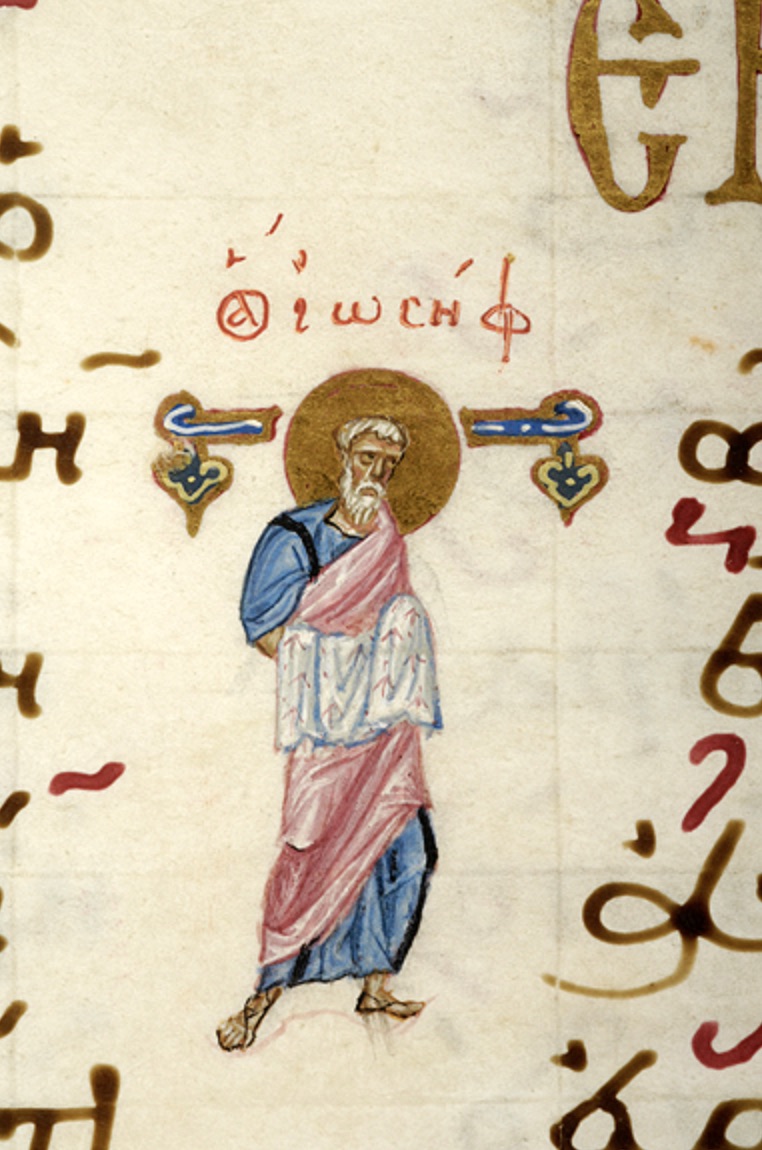
Say you’re interested in images of Joseph of Arimathea, for example, whether in a scene—such as the Deposition or the Entombment—or as an isolated figure. You might start with a simple keyword search for “Arimathea” on the database homepage, or you could also use the “Terms” tab on the “Advanced Search” page, checking “Description” and “Subject” in the “Search Fields” checklist, a strategy that currently yields a whopping 735 results.
Now let’s try using one of the filters. Simply switch to the “Filters” tab on the “Advanced Search” page. Feel free to explore, and try all or any of the filters. For the purposes of this demonstration, however, we’re thinking about language, so let’s start by narrowing our search to manuscripts. Simply select “Manuscript” in the Work of Art Type Filter (Example 1), then click “Search” again. You’ll discover that, in this case, you have nearly halved the search results to 373, but that’s still a lot of records to consider.

Now here comes the exciting part! If you know that you’re interested in a particular linguistic context, then you can add the Language Filter to your Advanced Search. There are currently 48 languages to choose from in the Index of Medieval Art database. For this demonstration, we’ve specified Greek (Example 2), so we’re searching for the word “Arimathea” where it appears in either the Subject field or the Description field, only in records for which the Work of Art Type is “Manuscript” and the language of the manuscript is “Greek.” Click “Search,” and you’ll discover that you have been able to filter your results down to a manageable 32 records!
Simple, n’est-ce pas?
You can easily change the Language filter to compare results from one language to another. Changing Greek to Armenian yields ten results. Church Slavonic yields six. Filtering for some languages may return nothing, others quite a lot. Latin, for example, returns 233 results, so you might want to add another filter to your search. For the time being, only the languages of manuscripts are identified in the database. Eventually, however, the Index database will identify the language or languages of every object that incorporates the written word.
You might have noticed that names of some languages include date ranges, as in “Middle English (1100–1500).” Although such dates can seem arbitrary, we try to differentiate among the stages of a language’s development. If you’re curious about how the Index defines a language, or about what sources we cite, you can click on the language name in the Language field of a Work of Art record. This will take you to a page where you can read the Language Details. There you’ll also find citations and external reference codes (Glottolog and ISO 639-3). On that page, there is also a list of all Work of Art References that include that language.
So, start exploring, and be sure to try out the filters available in the new Index of Medieval Art database. Also, please let us know what you think…but mind your language!
First in a series of short blog posts introducing the new features of our online database
Did you know that you can search The Index of Medieval Art for information about patrons of medieval art? The Index records both identified and unidentified patrons, the latter entered as grouping terms for types of patrons (Male, Female, Couple) and major monastic orders, such as Augustinian, Benedictine, and Carmelite. There are also general headings for anonymous male and female patrons (Male, unidentified and Female, unidentified). Names of churches, monasteries, and abbeys are given by their proper titles, such as Canterbury Cathedral, but might be further identified by location (e.g. Abbaye d’Anchin [Pecquencourt, France]).
For an overview of our patron headings, click on Browse at the top of the Index landing page. This will bring you to a list of over 900 names and grouping terms sorted in alphabetical order. To reach a specific entry, type the first few letters of a name into the search line at the top of the list. For instance, typing in “Blanche” will bring you to all Blanches from Burgundy, Castile, France, Navarre, and also the late 14th-century Countess of Geneva. Clicking on any patron heading will return a glossary entry comprising a biographical note with dates, alternate names of the patron, a bibliographic citation, an external reference for the authority source, and all the work of art examples linked to that patron.
Our patron entries are formatted in keeping with standard biographical authorities, such as the Library of Congress Name Authority File, the Virtual International Authority File (VIAF), and Oxford References. Patrons are identified in the Index database by their roles and dates when these are known. When performing an Advanced Search in the “Terms” screen, you may prefer to keep the Match Type set to “Default,” which will search all parts of the heading. In the “Terms” window, a search can be formulated with keywords such as “Pope,” “Doge,” or “Prince,” using “Patron” in Search Fields to locate medieval patrons by their role. Similar keywords, along with keywords for place indicators like “Monastery” or “Convent,” can be searched against the “Patron Note” field, which will search the biographical notes in the patron glossary.
Many of the monastic patrons contain their locations in parentheses after the name of the community, so countries of patronage activity can also be searched as keywords. For instance, searching against “Patron” or “Patron Notes” with the keyword “Italy” returns over 150 records. This indicates artwork results for a patron who was active in Italy. From here, in the “Filters” window, the Date Slider can be used to refine results. The “Terms” search can be refined with any of the additional filters, including “Location,” “Medium,” “Style/ Culture,” and “Work of Art Type.”
Are you interested in finding out which female patrons were active in France in the 14th century?
In the Advanced Search “Terms” screen, enter the keyword “Female” and choose the Search Field “Patron” (keeping Match Type set to “Default,” as recommended).
Then, go to “Filters,” select “France” as a Location, and set the Date Slider to 1300 and 1399. This search should yield 27 examples, where a female patron is connected to the 14th century work made in any part of France.
*In results, please note that work of art records will include Main records indicated with a logo picture.
As you search for patrons in the new Index of Medieval Art database, bear in mind that visual representations of patrons are found in the Subject field. To find images of patrons, you can browse or search the Subject field with the keyword “Donor.” To read more about medieval patronage practices in general, you might find the Index’s 2013 conference publication Patronage, Power, and Agency in Medieval Art of interest. Enjoy refining your searches and browsing the range of patrons we record in the Index! And please remember that we are always happy to have your feedback. Get in touch with us at theindex@princeton.edu.